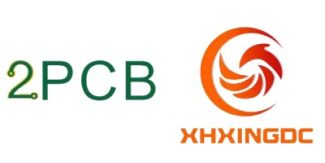Copper coating is an important part of PCB design. Do you know it? The so-called copper coating is to use the idle space on the PCB as the reference surface and then fill it with solid copper. These copper areas are also called copper filling. The significance of copper coating is to reduce the impedance of the ground line and improve the anti-interference ability; reduce the voltage drop and improve the power supply efficiency; connect to the ground line, and it can also reduce the loop area, etc.
Copper coating method
There are generally two basic ways of copper coating, which is large-area copper coating (solid copper coating) and grid copper. Is large-area copper coating better or grid copper coating better? It is not easy to generalize. They each have advantages and disadvantages.
1. Solid copper coating
Advantages: It has the dual functions of increasing current and shielding.
Disadvantages: If the board is wave soldered, it may warp up or even bubble.
Solution: Generally, several grooves will be opened to alleviate the blistering of copper foil.
2. Grid copper coating
Advantages: From the perspective of heat dissipation, the grid has advantages (it reduces the heating surface of copper) and plays a certain role in electromagnetic shielding.
Disadvantages: The main function of pure grid copper coating is shielding, and the effect of increasing current is reduced.
Advantages and disadvantages of copper coating
Advantages:
Provide additional shielding protection and noise suppression for inner layer signals.
Improve the heat dissipation capacity of PCB.
In the PCB production process, save the amount of corrosive agent.
Avoid the warping and deformation of PCB due to different stresses generated during PCB reflow soldering caused by uneven copper foil.
Disadvantages:
The outer copper-clad plane will be separated and fragmented by the components and signal lines on the surface. If there is poorly grounded copper foil (especially the thin and long copper fragments), it will become an antenna and cause EMI problems.
If the component pins are fully connected with copper coating, the heat will be lost too quickly, making desoldering and rework soldering difficult.
The outer copper-clad plane must be well grounded, and more vias need to be drilled to connect to the main ground plane. Too many vias will inevitably affect the wiring channel, unless buried blind holes are used.
Notes on copper-clad
When engineers are copper-clad, in order to achieve the desired effect, they need to pay attention to the following aspects:
1. If there are many grounds on the PCB, such as SGND, AGND, GND, etc., it is necessary to use the most important “ground” as a reference for independent copper-clad according to the different positions of the PCB board. It goes without saying that the digital ground and the analog ground are separately copper-clad. At the same time, before copper-clad, first thicken the corresponding power connection: 5.0V, 3.3V, etc., so that multiple deformable structures of different shapes are formed.
2. For single-point connection of different grounds, the method is to connect through 0 ohm resistors, magnetic beads or inductors.
3. Copper-clad near the crystal oscillator. The crystal oscillator in the circuit is a high-frequency emission source. The method is to copper-clad around the crystal oscillator and then ground the shell of the crystal oscillator separately.
4. If you think the island (dead zone) problem is too big, it won’t take much to define a ground via and add it in.
5. When starting to wire, treat the ground wires equally. When routing, you should route the ground wires well. You cannot rely on adding vias after copper cladding to eliminate the unconnected ground pins. This effect is very bad.
6. It is best not to have sharp corners on the board (<=180 degrees), because from the perspective of electromagnetics, this constitutes a transmitting antenna! For others, there will always be an impact, but it is just a matter of size. It is recommended to use the edge line of the arc.
7. Do not clad copper in the open area of the middle layer of the multilayer board. Because it is difficult for you to make this copper cladding “well grounded”.
8. The metal inside the device, such as metal radiators, metal reinforcement strips, etc., must be “well grounded”.
Summary: If the grounding problem is handled well, the copper cladding on the PCB is “more beneficial than harmful”. It can reduce the return area of the signal line and reduce the electromagnetic interference of the signal to the outside.
